Information Technology: Analyzing System Use in Organizations
VerifiedAdded on 2023/06/11
|12
|3375
|481
Report
AI Summary
This report discusses the importance of information systems in various organizations, highlighting their role in decision-making and achieving business goals. It covers the components of information systems, including input, processing, and output, and differentiates between manual and computer-based systems. The report also examines the use of information systems in different business functions such as transaction processing, e-commerce, and management information systems (MIS). Case studies illustrate the practical application of information systems in tracking pandemics, enhancing creativity in business, and implementing ERP systems. The report emphasizes the need for skilled professionals to manage these systems effectively and discusses the ethical considerations involved.
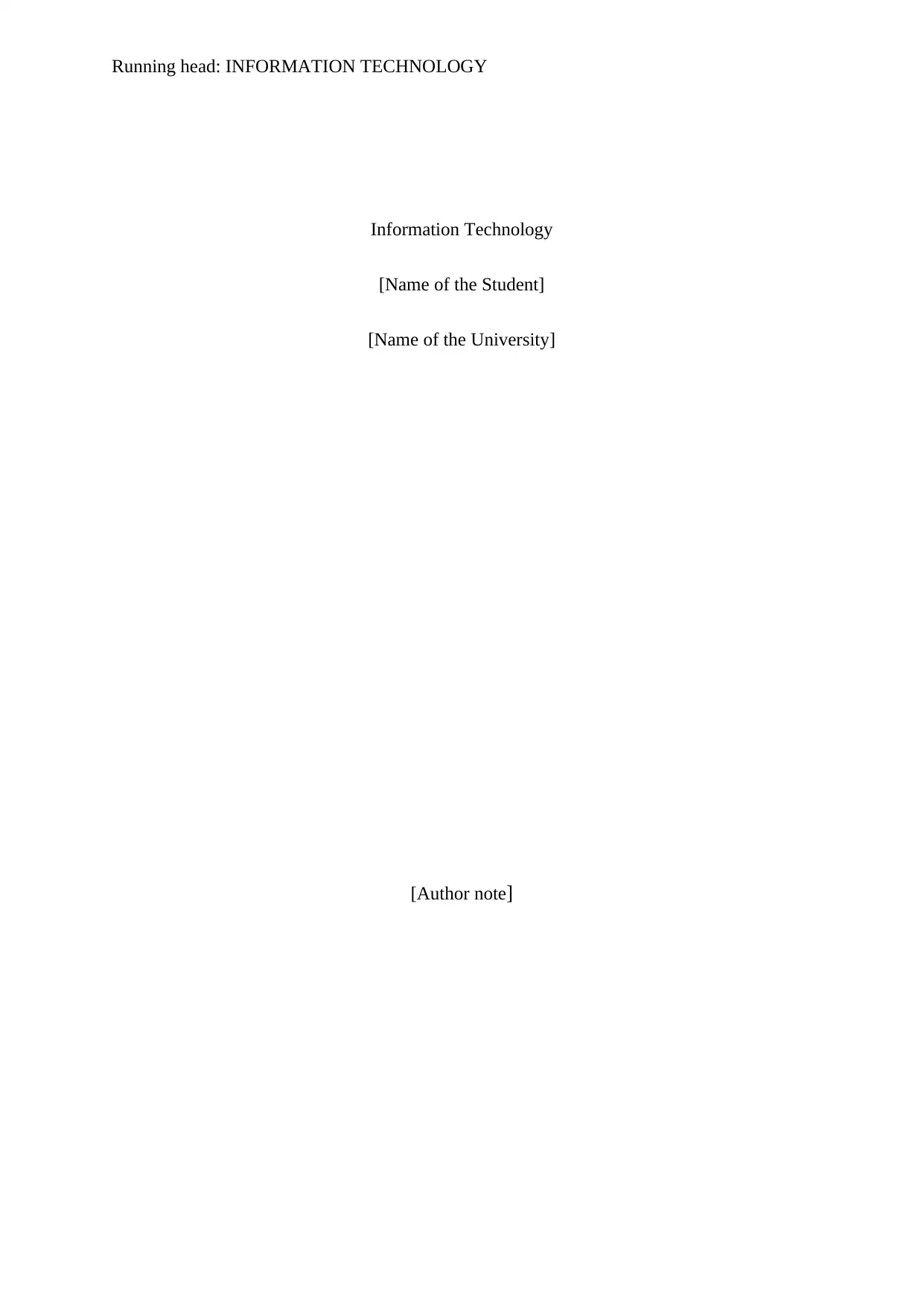
Running head: INFORMATION TECHNOLOGY
Information Technology
[Name of the Student]
[Name of the University]
[Author note]
Information Technology
[Name of the Student]
[Name of the University]
[Author note]
Paraphrase This Document
Need a fresh take? Get an instant paraphrase of this document with our AI Paraphraser
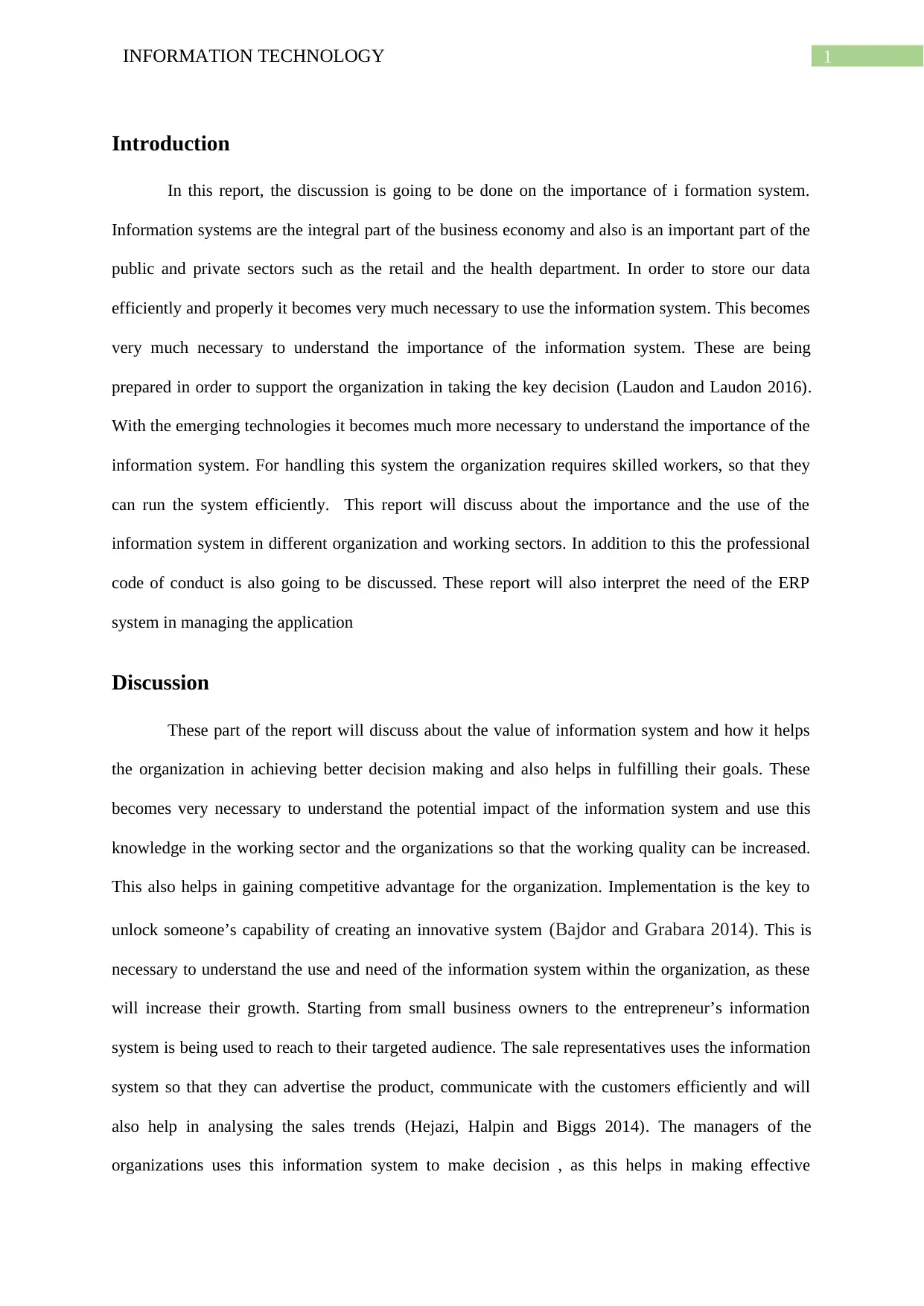
1INFORMATION TECHNOLOGY
Introduction
In this report, the discussion is going to be done on the importance of i formation system.
Information systems are the integral part of the business economy and also is an important part of the
public and private sectors such as the retail and the health department. In order to store our data
efficiently and properly it becomes very much necessary to use the information system. This becomes
very much necessary to understand the importance of the information system. These are being
prepared in order to support the organization in taking the key decision (Laudon and Laudon 2016).
With the emerging technologies it becomes much more necessary to understand the importance of the
information system. For handling this system the organization requires skilled workers, so that they
can run the system efficiently. This report will discuss about the importance and the use of the
information system in different organization and working sectors. In addition to this the professional
code of conduct is also going to be discussed. These report will also interpret the need of the ERP
system in managing the application
Discussion
These part of the report will discuss about the value of information system and how it helps
the organization in achieving better decision making and also helps in fulfilling their goals. These
becomes very necessary to understand the potential impact of the information system and use this
knowledge in the working sector and the organizations so that the working quality can be increased.
This also helps in gaining competitive advantage for the organization. Implementation is the key to
unlock someone’s capability of creating an innovative system (Bajdor and Grabara 2014). This is
necessary to understand the use and need of the information system within the organization, as these
will increase their growth. Starting from small business owners to the entrepreneur’s information
system is being used to reach to their targeted audience. The sale representatives uses the information
system so that they can advertise the product, communicate with the customers efficiently and will
also help in analysing the sales trends (Hejazi, Halpin and Biggs 2014). The managers of the
organizations uses this information system to make decision , as this helps in making effective
Introduction
In this report, the discussion is going to be done on the importance of i formation system.
Information systems are the integral part of the business economy and also is an important part of the
public and private sectors such as the retail and the health department. In order to store our data
efficiently and properly it becomes very much necessary to use the information system. This becomes
very much necessary to understand the importance of the information system. These are being
prepared in order to support the organization in taking the key decision (Laudon and Laudon 2016).
With the emerging technologies it becomes much more necessary to understand the importance of the
information system. For handling this system the organization requires skilled workers, so that they
can run the system efficiently. This report will discuss about the importance and the use of the
information system in different organization and working sectors. In addition to this the professional
code of conduct is also going to be discussed. These report will also interpret the need of the ERP
system in managing the application
Discussion
These part of the report will discuss about the value of information system and how it helps
the organization in achieving better decision making and also helps in fulfilling their goals. These
becomes very necessary to understand the potential impact of the information system and use this
knowledge in the working sector and the organizations so that the working quality can be increased.
This also helps in gaining competitive advantage for the organization. Implementation is the key to
unlock someone’s capability of creating an innovative system (Bajdor and Grabara 2014). This is
necessary to understand the use and need of the information system within the organization, as these
will increase their growth. Starting from small business owners to the entrepreneur’s information
system is being used to reach to their targeted audience. The sale representatives uses the information
system so that they can advertise the product, communicate with the customers efficiently and will
also help in analysing the sales trends (Hejazi, Halpin and Biggs 2014). The managers of the
organizations uses this information system to make decision , as this helps in making effective
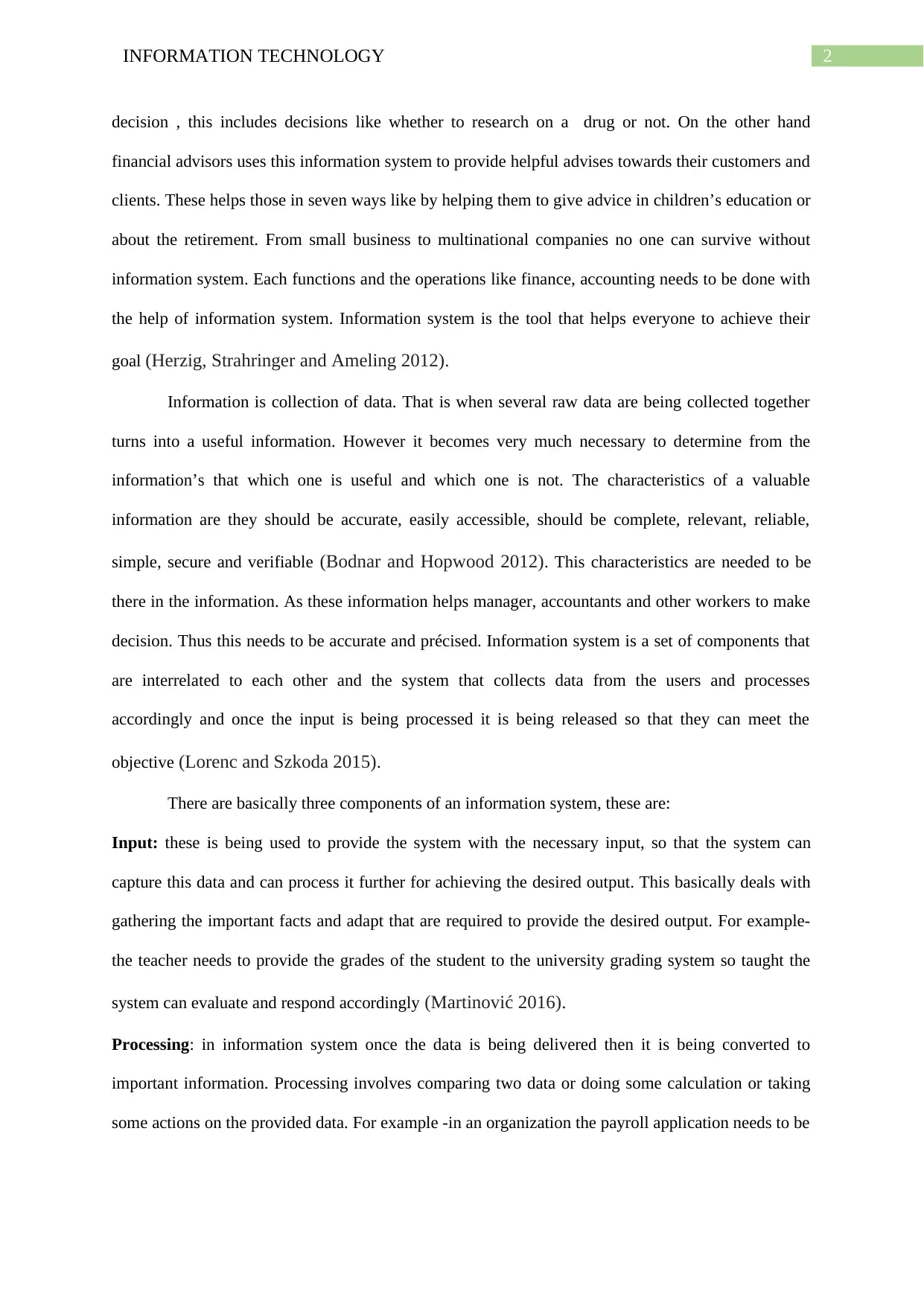
2INFORMATION TECHNOLOGY
decision , this includes decisions like whether to research on a drug or not. On the other hand
financial advisors uses this information system to provide helpful advises towards their customers and
clients. These helps those in seven ways like by helping them to give advice in children’s education or
about the retirement. From small business to multinational companies no one can survive without
information system. Each functions and the operations like finance, accounting needs to be done with
the help of information system. Information system is the tool that helps everyone to achieve their
goal (Herzig, Strahringer and Ameling 2012).
Information is collection of data. That is when several raw data are being collected together
turns into a useful information. However it becomes very much necessary to determine from the
information’s that which one is useful and which one is not. The characteristics of a valuable
information are they should be accurate, easily accessible, should be complete, relevant, reliable,
simple, secure and verifiable (Bodnar and Hopwood 2012). This characteristics are needed to be
there in the information. As these information helps manager, accountants and other workers to make
decision. Thus this needs to be accurate and précised. Information system is a set of components that
are interrelated to each other and the system that collects data from the users and processes
accordingly and once the input is being processed it is being released so that they can meet the
objective (Lorenc and Szkoda 2015).
There are basically three components of an information system, these are:
Input: these is being used to provide the system with the necessary input, so that the system can
capture this data and can process it further for achieving the desired output. This basically deals with
gathering the important facts and adapt that are required to provide the desired output. For example-
the teacher needs to provide the grades of the student to the university grading system so taught the
system can evaluate and respond accordingly (Martinović 2016).
Processing: in information system once the data is being delivered then it is being converted to
important information. Processing involves comparing two data or doing some calculation or taking
some actions on the provided data. For example -in an organization the payroll application needs to be
decision , this includes decisions like whether to research on a drug or not. On the other hand
financial advisors uses this information system to provide helpful advises towards their customers and
clients. These helps those in seven ways like by helping them to give advice in children’s education or
about the retirement. From small business to multinational companies no one can survive without
information system. Each functions and the operations like finance, accounting needs to be done with
the help of information system. Information system is the tool that helps everyone to achieve their
goal (Herzig, Strahringer and Ameling 2012).
Information is collection of data. That is when several raw data are being collected together
turns into a useful information. However it becomes very much necessary to determine from the
information’s that which one is useful and which one is not. The characteristics of a valuable
information are they should be accurate, easily accessible, should be complete, relevant, reliable,
simple, secure and verifiable (Bodnar and Hopwood 2012). This characteristics are needed to be
there in the information. As these information helps manager, accountants and other workers to make
decision. Thus this needs to be accurate and précised. Information system is a set of components that
are interrelated to each other and the system that collects data from the users and processes
accordingly and once the input is being processed it is being released so that they can meet the
objective (Lorenc and Szkoda 2015).
There are basically three components of an information system, these are:
Input: these is being used to provide the system with the necessary input, so that the system can
capture this data and can process it further for achieving the desired output. This basically deals with
gathering the important facts and adapt that are required to provide the desired output. For example-
the teacher needs to provide the grades of the student to the university grading system so taught the
system can evaluate and respond accordingly (Martinović 2016).
Processing: in information system once the data is being delivered then it is being converted to
important information. Processing involves comparing two data or doing some calculation or taking
some actions on the provided data. For example -in an organization the payroll application needs to be
⊘ This is a preview!⊘
Do you want full access?
Subscribe today to unlock all pages.

Trusted by 1+ million students worldwide
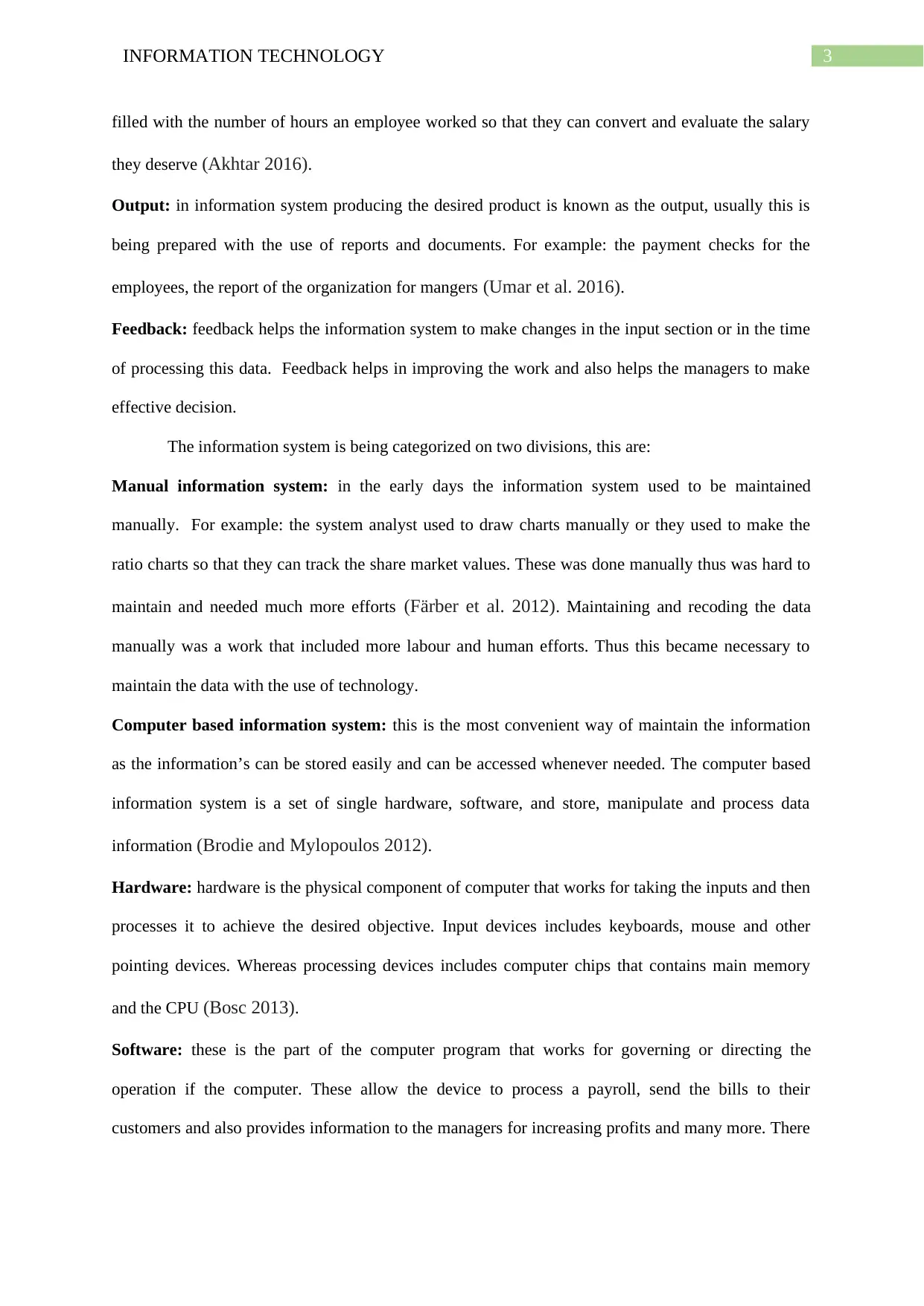
3INFORMATION TECHNOLOGY
filled with the number of hours an employee worked so that they can convert and evaluate the salary
they deserve (Akhtar 2016).
Output: in information system producing the desired product is known as the output, usually this is
being prepared with the use of reports and documents. For example: the payment checks for the
employees, the report of the organization for mangers (Umar et al. 2016).
Feedback: feedback helps the information system to make changes in the input section or in the time
of processing this data. Feedback helps in improving the work and also helps the managers to make
effective decision.
The information system is being categorized on two divisions, this are:
Manual information system: in the early days the information system used to be maintained
manually. For example: the system analyst used to draw charts manually or they used to make the
ratio charts so that they can track the share market values. These was done manually thus was hard to
maintain and needed much more efforts (Färber et al. 2012). Maintaining and recoding the data
manually was a work that included more labour and human efforts. Thus this became necessary to
maintain the data with the use of technology.
Computer based information system: this is the most convenient way of maintain the information
as the information’s can be stored easily and can be accessed whenever needed. The computer based
information system is a set of single hardware, software, and store, manipulate and process data
information (Brodie and Mylopoulos 2012).
Hardware: hardware is the physical component of computer that works for taking the inputs and then
processes it to achieve the desired objective. Input devices includes keyboards, mouse and other
pointing devices. Whereas processing devices includes computer chips that contains main memory
and the CPU (Bosc 2013).
Software: these is the part of the computer program that works for governing or directing the
operation if the computer. These allow the device to process a payroll, send the bills to their
customers and also provides information to the managers for increasing profits and many more. There
filled with the number of hours an employee worked so that they can convert and evaluate the salary
they deserve (Akhtar 2016).
Output: in information system producing the desired product is known as the output, usually this is
being prepared with the use of reports and documents. For example: the payment checks for the
employees, the report of the organization for mangers (Umar et al. 2016).
Feedback: feedback helps the information system to make changes in the input section or in the time
of processing this data. Feedback helps in improving the work and also helps the managers to make
effective decision.
The information system is being categorized on two divisions, this are:
Manual information system: in the early days the information system used to be maintained
manually. For example: the system analyst used to draw charts manually or they used to make the
ratio charts so that they can track the share market values. These was done manually thus was hard to
maintain and needed much more efforts (Färber et al. 2012). Maintaining and recoding the data
manually was a work that included more labour and human efforts. Thus this became necessary to
maintain the data with the use of technology.
Computer based information system: this is the most convenient way of maintain the information
as the information’s can be stored easily and can be accessed whenever needed. The computer based
information system is a set of single hardware, software, and store, manipulate and process data
information (Brodie and Mylopoulos 2012).
Hardware: hardware is the physical component of computer that works for taking the inputs and then
processes it to achieve the desired objective. Input devices includes keyboards, mouse and other
pointing devices. Whereas processing devices includes computer chips that contains main memory
and the CPU (Bosc 2013).
Software: these is the part of the computer program that works for governing or directing the
operation if the computer. These allow the device to process a payroll, send the bills to their
customers and also provides information to the managers for increasing profits and many more. There
Paraphrase This Document
Need a fresh take? Get an instant paraphrase of this document with our AI Paraphraser
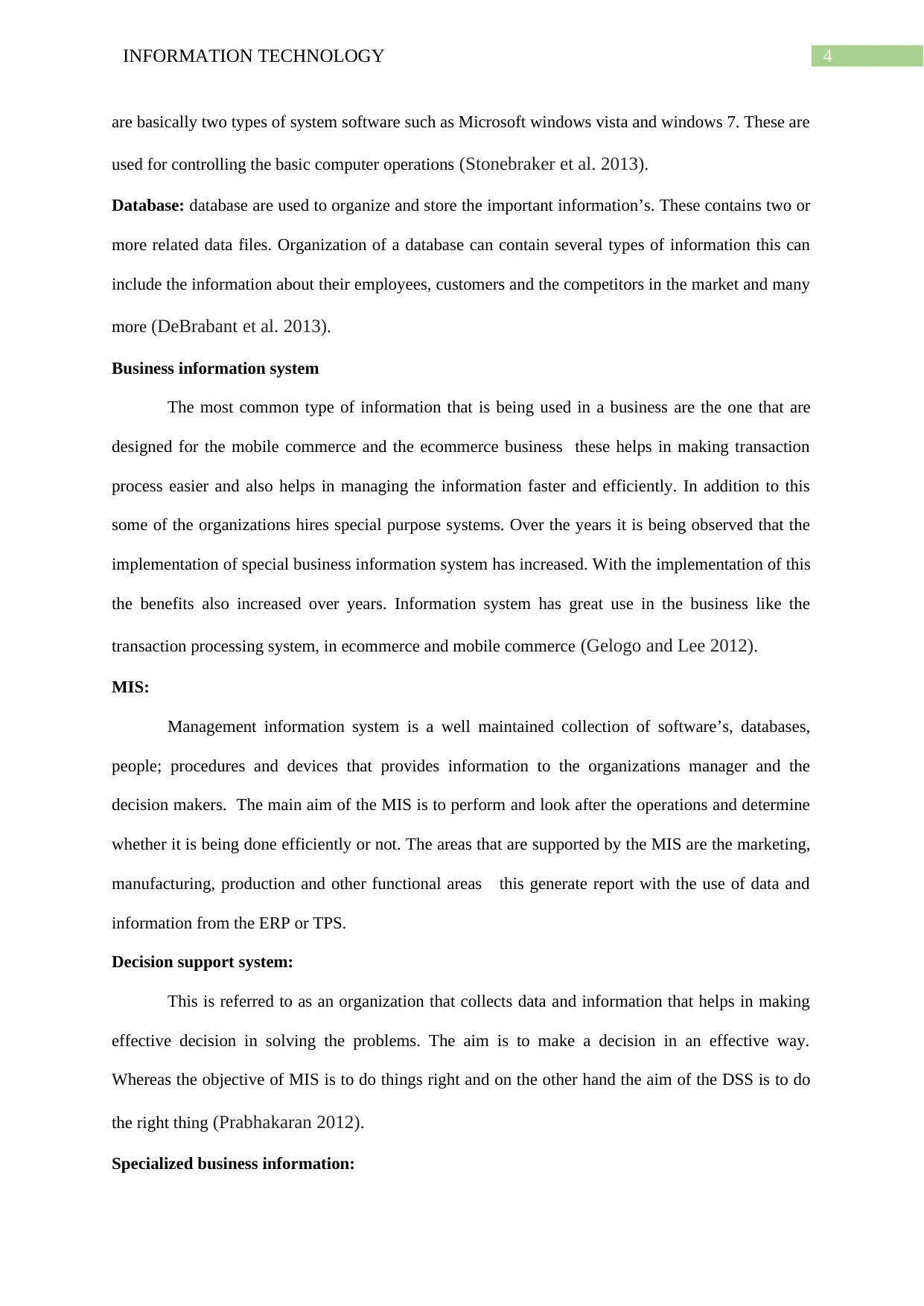
4INFORMATION TECHNOLOGY
are basically two types of system software such as Microsoft windows vista and windows 7. These are
used for controlling the basic computer operations (Stonebraker et al. 2013).
Database: database are used to organize and store the important information’s. These contains two or
more related data files. Organization of a database can contain several types of information this can
include the information about their employees, customers and the competitors in the market and many
more (DeBrabant et al. 2013).
Business information system
The most common type of information that is being used in a business are the one that are
designed for the mobile commerce and the ecommerce business these helps in making transaction
process easier and also helps in managing the information faster and efficiently. In addition to this
some of the organizations hires special purpose systems. Over the years it is being observed that the
implementation of special business information system has increased. With the implementation of this
the benefits also increased over years. Information system has great use in the business like the
transaction processing system, in ecommerce and mobile commerce (Gelogo and Lee 2012).
MIS:
Management information system is a well maintained collection of software’s, databases,
people; procedures and devices that provides information to the organizations manager and the
decision makers. The main aim of the MIS is to perform and look after the operations and determine
whether it is being done efficiently or not. The areas that are supported by the MIS are the marketing,
manufacturing, production and other functional areas this generate report with the use of data and
information from the ERP or TPS.
Decision support system:
This is referred to as an organization that collects data and information that helps in making
effective decision in solving the problems. The aim is to make a decision in an effective way.
Whereas the objective of MIS is to do things right and on the other hand the aim of the DSS is to do
the right thing (Prabhakaran 2012).
Specialized business information:
are basically two types of system software such as Microsoft windows vista and windows 7. These are
used for controlling the basic computer operations (Stonebraker et al. 2013).
Database: database are used to organize and store the important information’s. These contains two or
more related data files. Organization of a database can contain several types of information this can
include the information about their employees, customers and the competitors in the market and many
more (DeBrabant et al. 2013).
Business information system
The most common type of information that is being used in a business are the one that are
designed for the mobile commerce and the ecommerce business these helps in making transaction
process easier and also helps in managing the information faster and efficiently. In addition to this
some of the organizations hires special purpose systems. Over the years it is being observed that the
implementation of special business information system has increased. With the implementation of this
the benefits also increased over years. Information system has great use in the business like the
transaction processing system, in ecommerce and mobile commerce (Gelogo and Lee 2012).
MIS:
Management information system is a well maintained collection of software’s, databases,
people; procedures and devices that provides information to the organizations manager and the
decision makers. The main aim of the MIS is to perform and look after the operations and determine
whether it is being done efficiently or not. The areas that are supported by the MIS are the marketing,
manufacturing, production and other functional areas this generate report with the use of data and
information from the ERP or TPS.
Decision support system:
This is referred to as an organization that collects data and information that helps in making
effective decision in solving the problems. The aim is to make a decision in an effective way.
Whereas the objective of MIS is to do things right and on the other hand the aim of the DSS is to do
the right thing (Prabhakaran 2012).
Specialized business information:
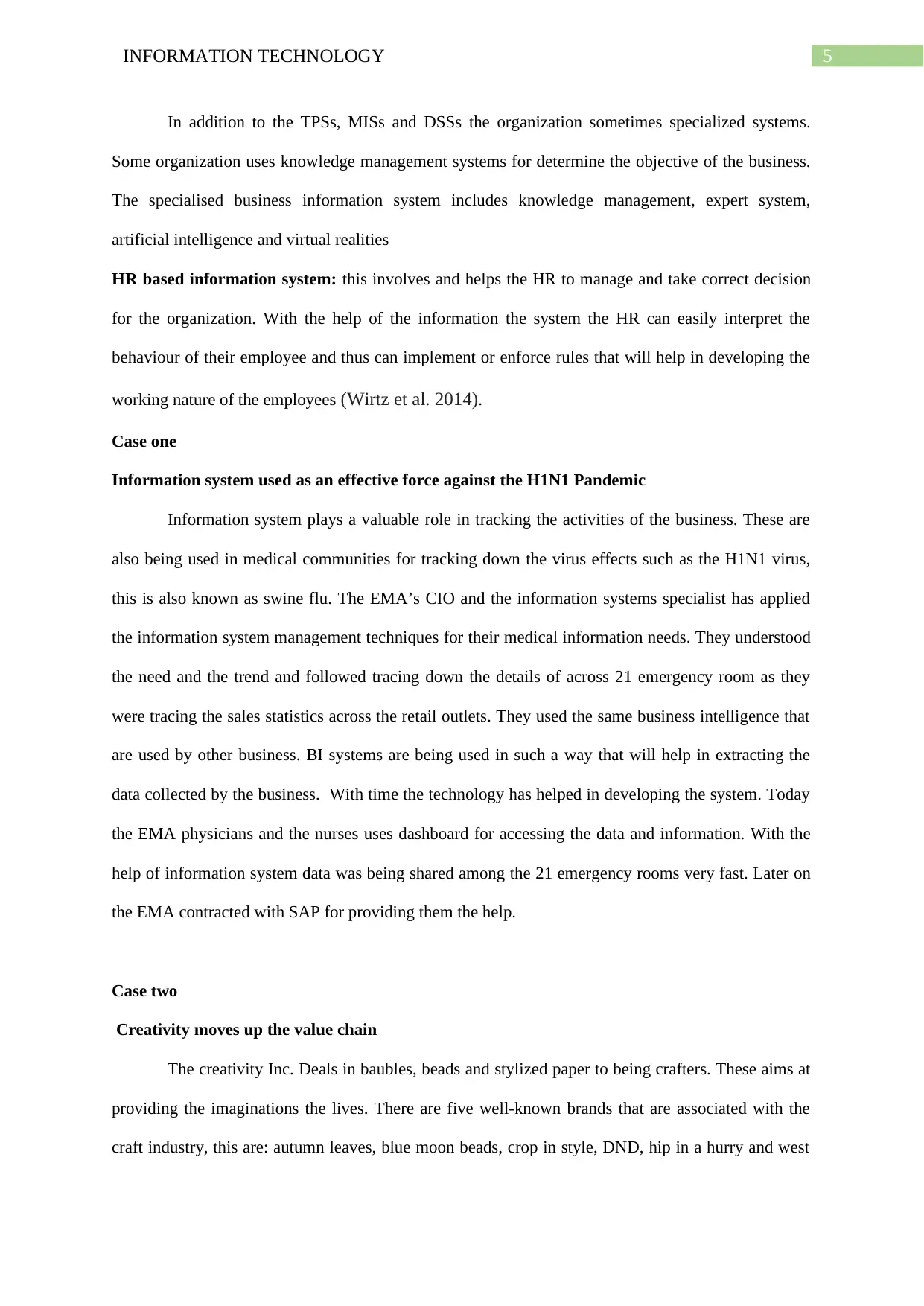
5INFORMATION TECHNOLOGY
In addition to the TPSs, MISs and DSSs the organization sometimes specialized systems.
Some organization uses knowledge management systems for determine the objective of the business.
The specialised business information system includes knowledge management, expert system,
artificial intelligence and virtual realities
HR based information system: this involves and helps the HR to manage and take correct decision
for the organization. With the help of the information the system the HR can easily interpret the
behaviour of their employee and thus can implement or enforce rules that will help in developing the
working nature of the employees (Wirtz et al. 2014).
Case one
Information system used as an effective force against the H1N1 Pandemic
Information system plays a valuable role in tracking the activities of the business. These are
also being used in medical communities for tracking down the virus effects such as the H1N1 virus,
this is also known as swine flu. The EMA’s CIO and the information systems specialist has applied
the information system management techniques for their medical information needs. They understood
the need and the trend and followed tracing down the details of across 21 emergency room as they
were tracing the sales statistics across the retail outlets. They used the same business intelligence that
are used by other business. BI systems are being used in such a way that will help in extracting the
data collected by the business. With time the technology has helped in developing the system. Today
the EMA physicians and the nurses uses dashboard for accessing the data and information. With the
help of information system data was being shared among the 21 emergency rooms very fast. Later on
the EMA contracted with SAP for providing them the help.
Case two
Creativity moves up the value chain
The creativity Inc. Deals in baubles, beads and stylized paper to being crafters. These aims at
providing the imaginations the lives. There are five well-known brands that are associated with the
craft industry, this are: autumn leaves, blue moon beads, crop in style, DND, hip in a hurry and west
In addition to the TPSs, MISs and DSSs the organization sometimes specialized systems.
Some organization uses knowledge management systems for determine the objective of the business.
The specialised business information system includes knowledge management, expert system,
artificial intelligence and virtual realities
HR based information system: this involves and helps the HR to manage and take correct decision
for the organization. With the help of the information the system the HR can easily interpret the
behaviour of their employee and thus can implement or enforce rules that will help in developing the
working nature of the employees (Wirtz et al. 2014).
Case one
Information system used as an effective force against the H1N1 Pandemic
Information system plays a valuable role in tracking the activities of the business. These are
also being used in medical communities for tracking down the virus effects such as the H1N1 virus,
this is also known as swine flu. The EMA’s CIO and the information systems specialist has applied
the information system management techniques for their medical information needs. They understood
the need and the trend and followed tracing down the details of across 21 emergency room as they
were tracing the sales statistics across the retail outlets. They used the same business intelligence that
are used by other business. BI systems are being used in such a way that will help in extracting the
data collected by the business. With time the technology has helped in developing the system. Today
the EMA physicians and the nurses uses dashboard for accessing the data and information. With the
help of information system data was being shared among the 21 emergency rooms very fast. Later on
the EMA contracted with SAP for providing them the help.
Case two
Creativity moves up the value chain
The creativity Inc. Deals in baubles, beads and stylized paper to being crafters. These aims at
providing the imaginations the lives. There are five well-known brands that are associated with the
craft industry, this are: autumn leaves, blue moon beads, crop in style, DND, hip in a hurry and west
⊘ This is a preview!⊘
Do you want full access?
Subscribe today to unlock all pages.

Trusted by 1+ million students worldwide
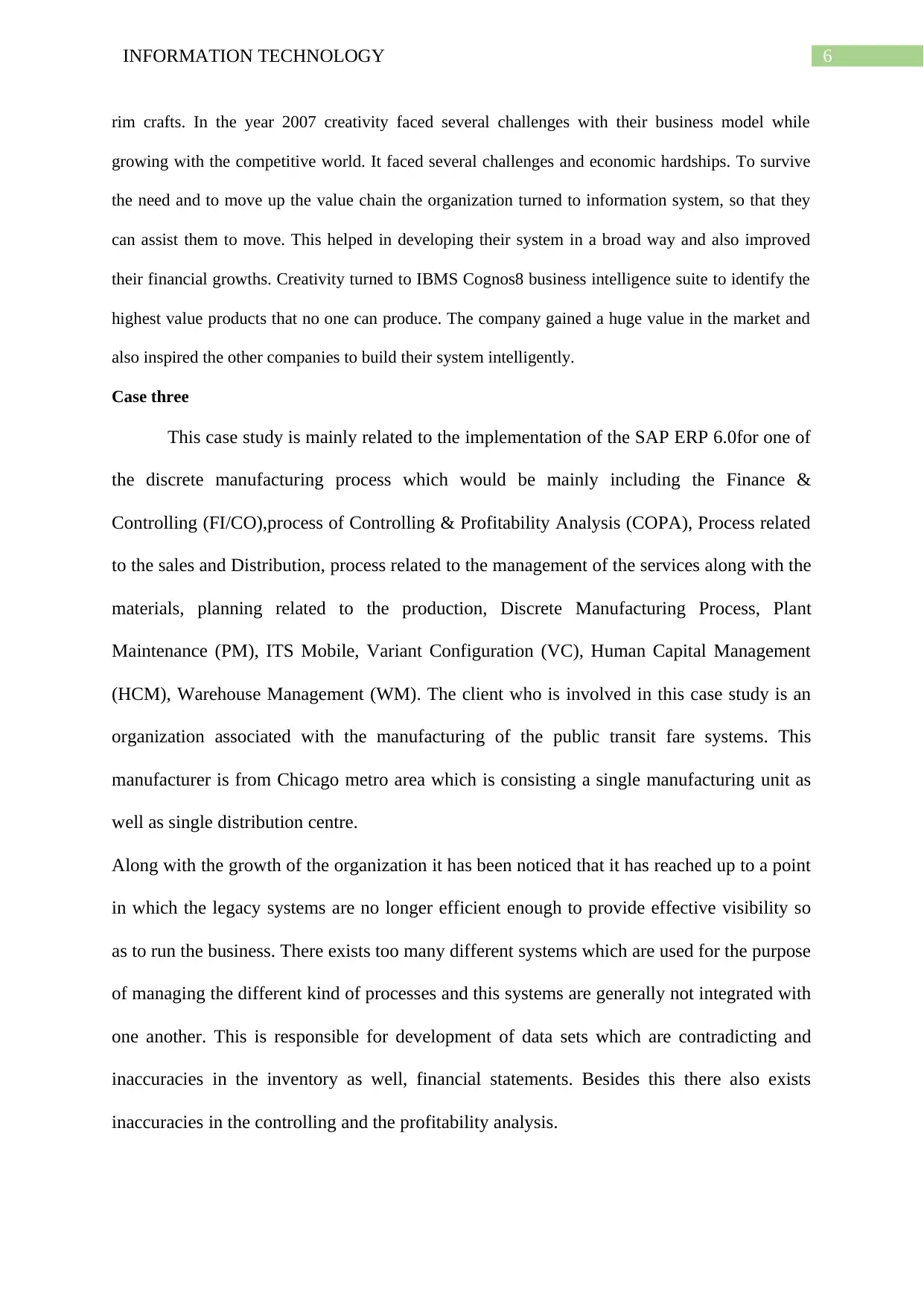
6INFORMATION TECHNOLOGY
rim crafts. In the year 2007 creativity faced several challenges with their business model while
growing with the competitive world. It faced several challenges and economic hardships. To survive
the need and to move up the value chain the organization turned to information system, so that they
can assist them to move. This helped in developing their system in a broad way and also improved
their financial growths. Creativity turned to IBMS Cognos8 business intelligence suite to identify the
highest value products that no one can produce. The company gained a huge value in the market and
also inspired the other companies to build their system intelligently.
Case three
This case study is mainly related to the implementation of the SAP ERP 6.0for one of
the discrete manufacturing process which would be mainly including the Finance &
Controlling (FI/CO),process of Controlling & Profitability Analysis (COPA), Process related
to the sales and Distribution, process related to the management of the services along with the
materials, planning related to the production, Discrete Manufacturing Process, Plant
Maintenance (PM), ITS Mobile, Variant Configuration (VC), Human Capital Management
(HCM), Warehouse Management (WM). The client who is involved in this case study is an
organization associated with the manufacturing of the public transit fare systems. This
manufacturer is from Chicago metro area which is consisting a single manufacturing unit as
well as single distribution centre.
Along with the growth of the organization it has been noticed that it has reached up to a point
in which the legacy systems are no longer efficient enough to provide effective visibility so
as to run the business. There exists too many different systems which are used for the purpose
of managing the different kind of processes and this systems are generally not integrated with
one another. This is responsible for development of data sets which are contradicting and
inaccuracies in the inventory as well, financial statements. Besides this there also exists
inaccuracies in the controlling and the profitability analysis.
rim crafts. In the year 2007 creativity faced several challenges with their business model while
growing with the competitive world. It faced several challenges and economic hardships. To survive
the need and to move up the value chain the organization turned to information system, so that they
can assist them to move. This helped in developing their system in a broad way and also improved
their financial growths. Creativity turned to IBMS Cognos8 business intelligence suite to identify the
highest value products that no one can produce. The company gained a huge value in the market and
also inspired the other companies to build their system intelligently.
Case three
This case study is mainly related to the implementation of the SAP ERP 6.0for one of
the discrete manufacturing process which would be mainly including the Finance &
Controlling (FI/CO),process of Controlling & Profitability Analysis (COPA), Process related
to the sales and Distribution, process related to the management of the services along with the
materials, planning related to the production, Discrete Manufacturing Process, Plant
Maintenance (PM), ITS Mobile, Variant Configuration (VC), Human Capital Management
(HCM), Warehouse Management (WM). The client who is involved in this case study is an
organization associated with the manufacturing of the public transit fare systems. This
manufacturer is from Chicago metro area which is consisting a single manufacturing unit as
well as single distribution centre.
Along with the growth of the organization it has been noticed that it has reached up to a point
in which the legacy systems are no longer efficient enough to provide effective visibility so
as to run the business. There exists too many different systems which are used for the purpose
of managing the different kind of processes and this systems are generally not integrated with
one another. This is responsible for development of data sets which are contradicting and
inaccuracies in the inventory as well, financial statements. Besides this there also exists
inaccuracies in the controlling and the profitability analysis.
Paraphrase This Document
Need a fresh take? Get an instant paraphrase of this document with our AI Paraphraser
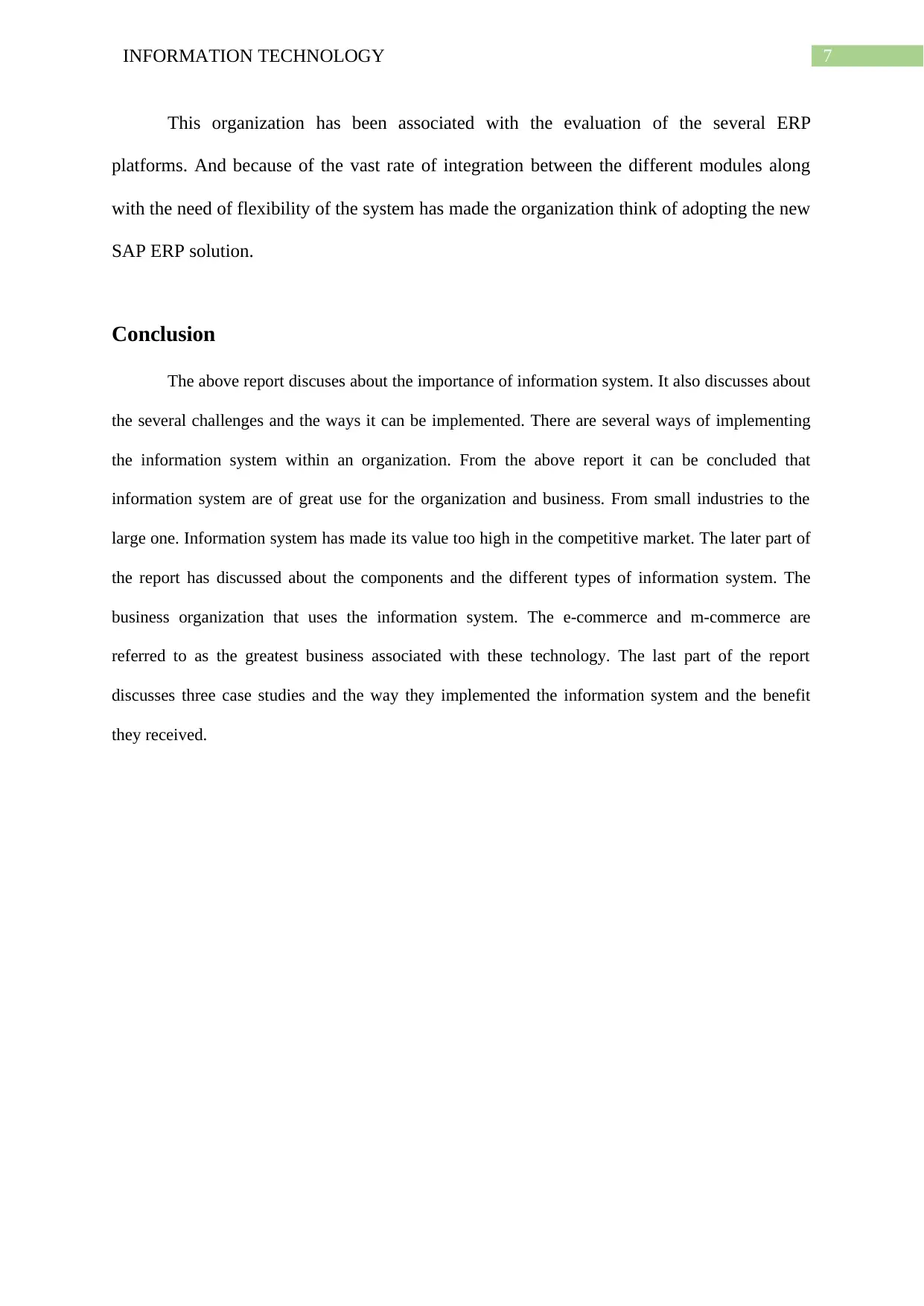
7INFORMATION TECHNOLOGY
This organization has been associated with the evaluation of the several ERP
platforms. And because of the vast rate of integration between the different modules along
with the need of flexibility of the system has made the organization think of adopting the new
SAP ERP solution.
Conclusion
The above report discuses about the importance of information system. It also discusses about
the several challenges and the ways it can be implemented. There are several ways of implementing
the information system within an organization. From the above report it can be concluded that
information system are of great use for the organization and business. From small industries to the
large one. Information system has made its value too high in the competitive market. The later part of
the report has discussed about the components and the different types of information system. The
business organization that uses the information system. The e-commerce and m-commerce are
referred to as the greatest business associated with these technology. The last part of the report
discusses three case studies and the way they implemented the information system and the benefit
they received.
This organization has been associated with the evaluation of the several ERP
platforms. And because of the vast rate of integration between the different modules along
with the need of flexibility of the system has made the organization think of adopting the new
SAP ERP solution.
Conclusion
The above report discuses about the importance of information system. It also discusses about
the several challenges and the ways it can be implemented. There are several ways of implementing
the information system within an organization. From the above report it can be concluded that
information system are of great use for the organization and business. From small industries to the
large one. Information system has made its value too high in the competitive market. The later part of
the report has discussed about the components and the different types of information system. The
business organization that uses the information system. The e-commerce and m-commerce are
referred to as the greatest business associated with these technology. The last part of the report
discusses three case studies and the way they implemented the information system and the benefit
they received.
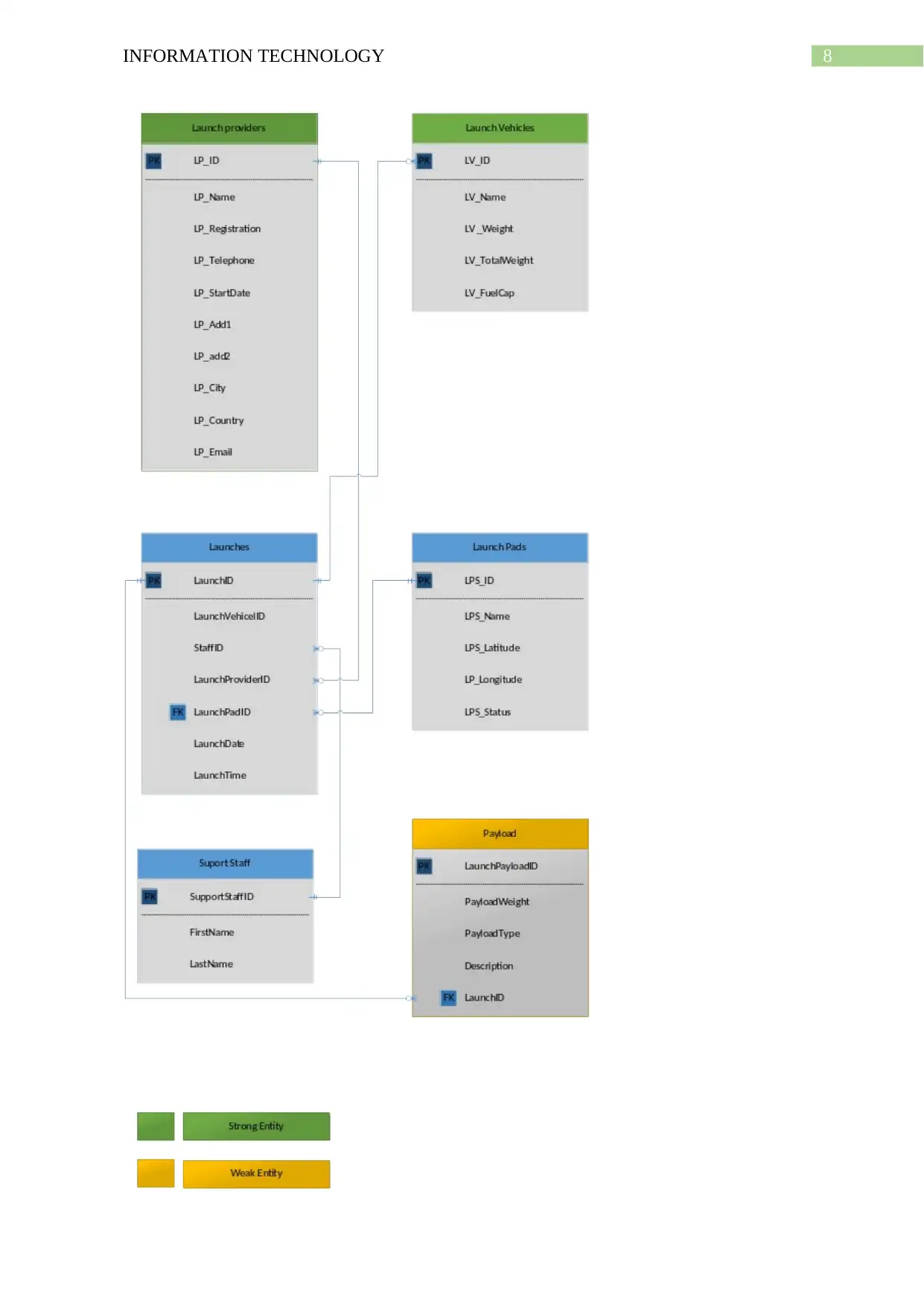
8INFORMATION TECHNOLOGY
⊘ This is a preview!⊘
Do you want full access?
Subscribe today to unlock all pages.

Trusted by 1+ million students worldwide
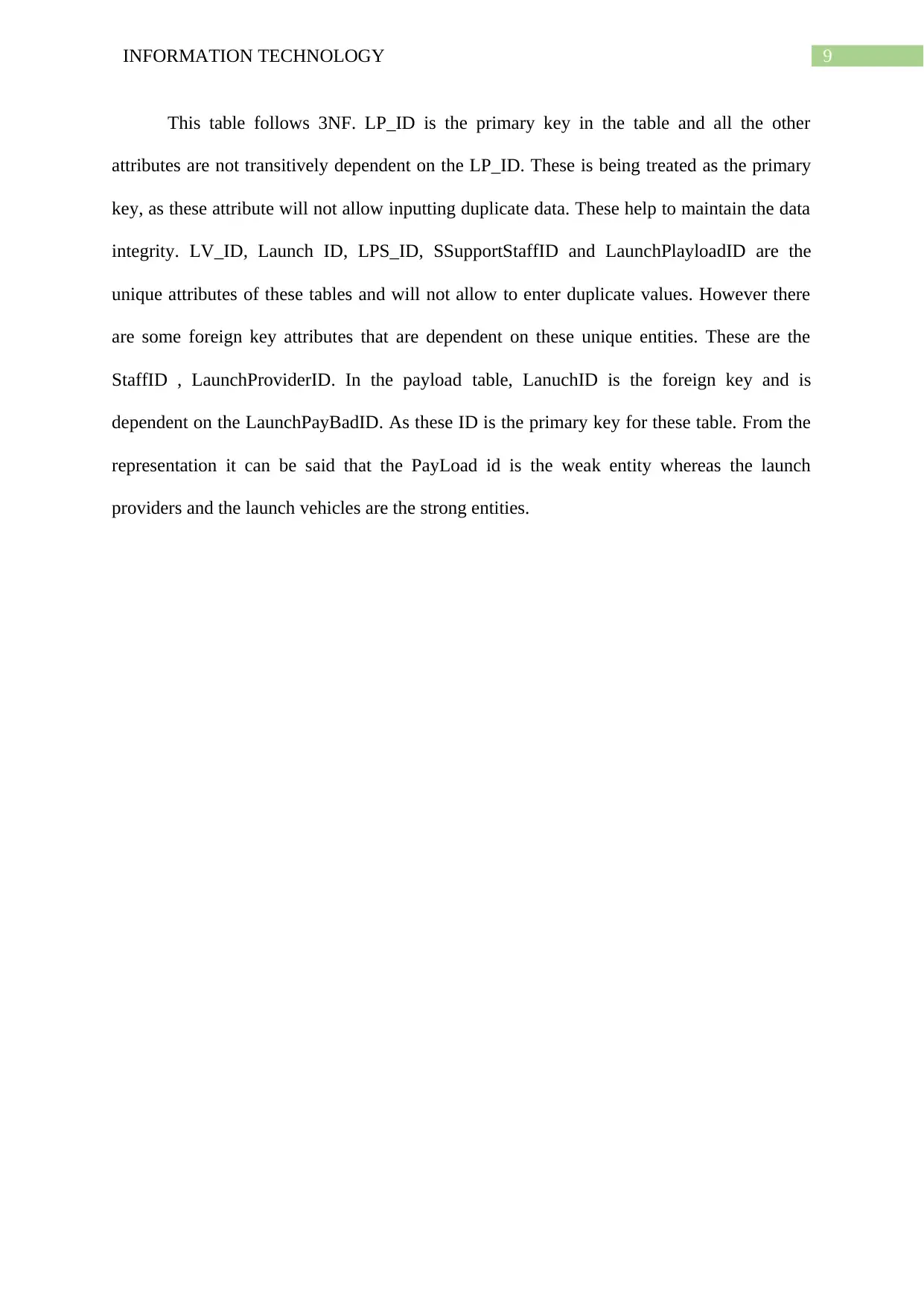
9INFORMATION TECHNOLOGY
This table follows 3NF. LP_ID is the primary key in the table and all the other
attributes are not transitively dependent on the LP_ID. These is being treated as the primary
key, as these attribute will not allow inputting duplicate data. These help to maintain the data
integrity. LV_ID, Launch ID, LPS_ID, SSupportStaffID and LaunchPlayloadID are the
unique attributes of these tables and will not allow to enter duplicate values. However there
are some foreign key attributes that are dependent on these unique entities. These are the
StaffID , LaunchProviderID. In the payload table, LanuchID is the foreign key and is
dependent on the LaunchPayBadID. As these ID is the primary key for these table. From the
representation it can be said that the PayLoad id is the weak entity whereas the launch
providers and the launch vehicles are the strong entities.
This table follows 3NF. LP_ID is the primary key in the table and all the other
attributes are not transitively dependent on the LP_ID. These is being treated as the primary
key, as these attribute will not allow inputting duplicate data. These help to maintain the data
integrity. LV_ID, Launch ID, LPS_ID, SSupportStaffID and LaunchPlayloadID are the
unique attributes of these tables and will not allow to enter duplicate values. However there
are some foreign key attributes that are dependent on these unique entities. These are the
StaffID , LaunchProviderID. In the payload table, LanuchID is the foreign key and is
dependent on the LaunchPayBadID. As these ID is the primary key for these table. From the
representation it can be said that the PayLoad id is the weak entity whereas the launch
providers and the launch vehicles are the strong entities.
Paraphrase This Document
Need a fresh take? Get an instant paraphrase of this document with our AI Paraphraser
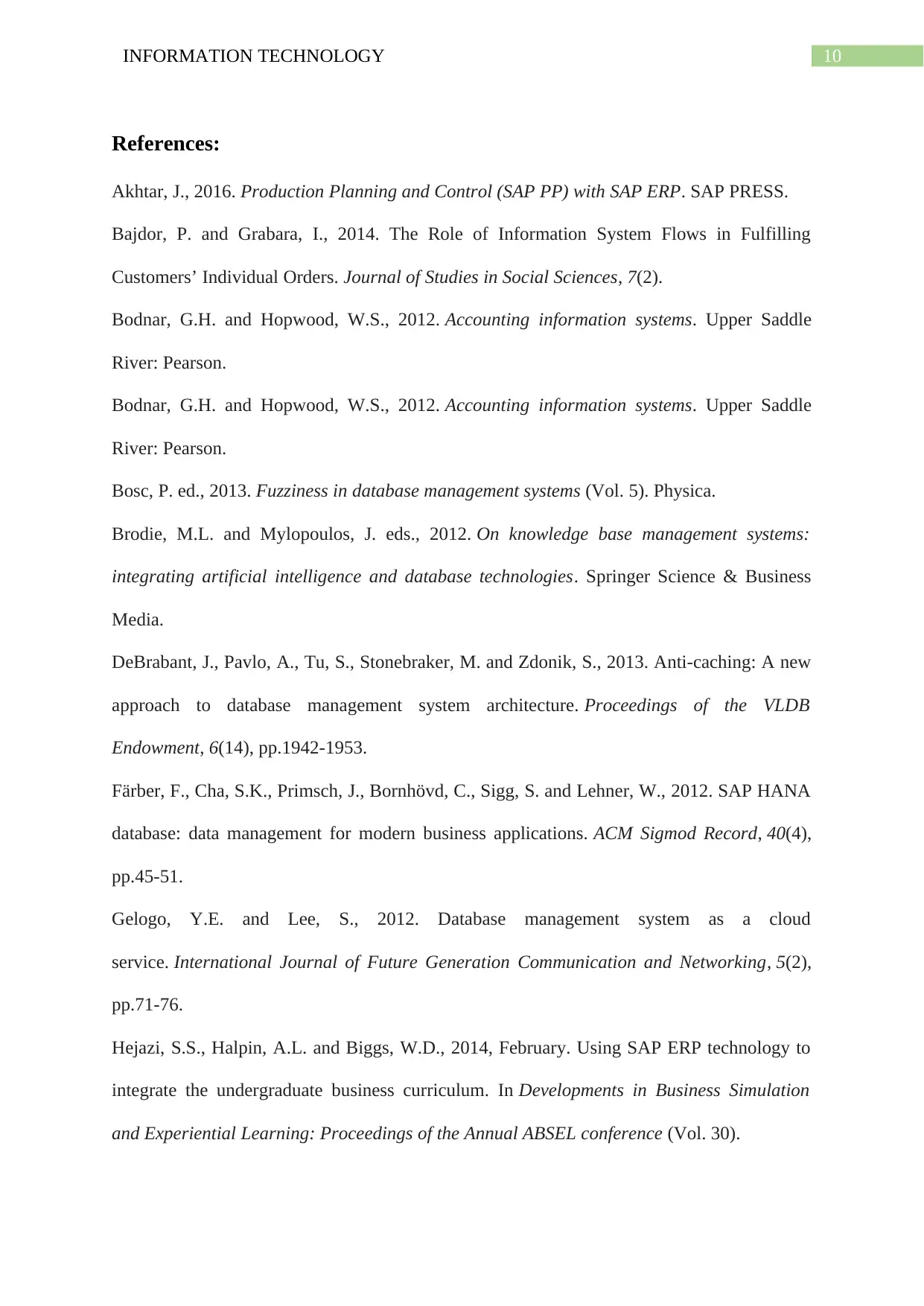
10INFORMATION TECHNOLOGY
References:
Akhtar, J., 2016. Production Planning and Control (SAP PP) with SAP ERP. SAP PRESS.
Bajdor, P. and Grabara, I., 2014. The Role of Information System Flows in Fulfilling
Customers’ Individual Orders. Journal of Studies in Social Sciences, 7(2).
Bodnar, G.H. and Hopwood, W.S., 2012. Accounting information systems. Upper Saddle
River: Pearson.
Bodnar, G.H. and Hopwood, W.S., 2012. Accounting information systems. Upper Saddle
River: Pearson.
Bosc, P. ed., 2013. Fuzziness in database management systems (Vol. 5). Physica.
Brodie, M.L. and Mylopoulos, J. eds., 2012. On knowledge base management systems:
integrating artificial intelligence and database technologies. Springer Science & Business
Media.
DeBrabant, J., Pavlo, A., Tu, S., Stonebraker, M. and Zdonik, S., 2013. Anti-caching: A new
approach to database management system architecture. Proceedings of the VLDB
Endowment, 6(14), pp.1942-1953.
Färber, F., Cha, S.K., Primsch, J., Bornhövd, C., Sigg, S. and Lehner, W., 2012. SAP HANA
database: data management for modern business applications. ACM Sigmod Record, 40(4),
pp.45-51.
Gelogo, Y.E. and Lee, S., 2012. Database management system as a cloud
service. International Journal of Future Generation Communication and Networking, 5(2),
pp.71-76.
Hejazi, S.S., Halpin, A.L. and Biggs, W.D., 2014, February. Using SAP ERP technology to
integrate the undergraduate business curriculum. In Developments in Business Simulation
and Experiential Learning: Proceedings of the Annual ABSEL conference (Vol. 30).
References:
Akhtar, J., 2016. Production Planning and Control (SAP PP) with SAP ERP. SAP PRESS.
Bajdor, P. and Grabara, I., 2014. The Role of Information System Flows in Fulfilling
Customers’ Individual Orders. Journal of Studies in Social Sciences, 7(2).
Bodnar, G.H. and Hopwood, W.S., 2012. Accounting information systems. Upper Saddle
River: Pearson.
Bodnar, G.H. and Hopwood, W.S., 2012. Accounting information systems. Upper Saddle
River: Pearson.
Bosc, P. ed., 2013. Fuzziness in database management systems (Vol. 5). Physica.
Brodie, M.L. and Mylopoulos, J. eds., 2012. On knowledge base management systems:
integrating artificial intelligence and database technologies. Springer Science & Business
Media.
DeBrabant, J., Pavlo, A., Tu, S., Stonebraker, M. and Zdonik, S., 2013. Anti-caching: A new
approach to database management system architecture. Proceedings of the VLDB
Endowment, 6(14), pp.1942-1953.
Färber, F., Cha, S.K., Primsch, J., Bornhövd, C., Sigg, S. and Lehner, W., 2012. SAP HANA
database: data management for modern business applications. ACM Sigmod Record, 40(4),
pp.45-51.
Gelogo, Y.E. and Lee, S., 2012. Database management system as a cloud
service. International Journal of Future Generation Communication and Networking, 5(2),
pp.71-76.
Hejazi, S.S., Halpin, A.L. and Biggs, W.D., 2014, February. Using SAP ERP technology to
integrate the undergraduate business curriculum. In Developments in Business Simulation
and Experiential Learning: Proceedings of the Annual ABSEL conference (Vol. 30).
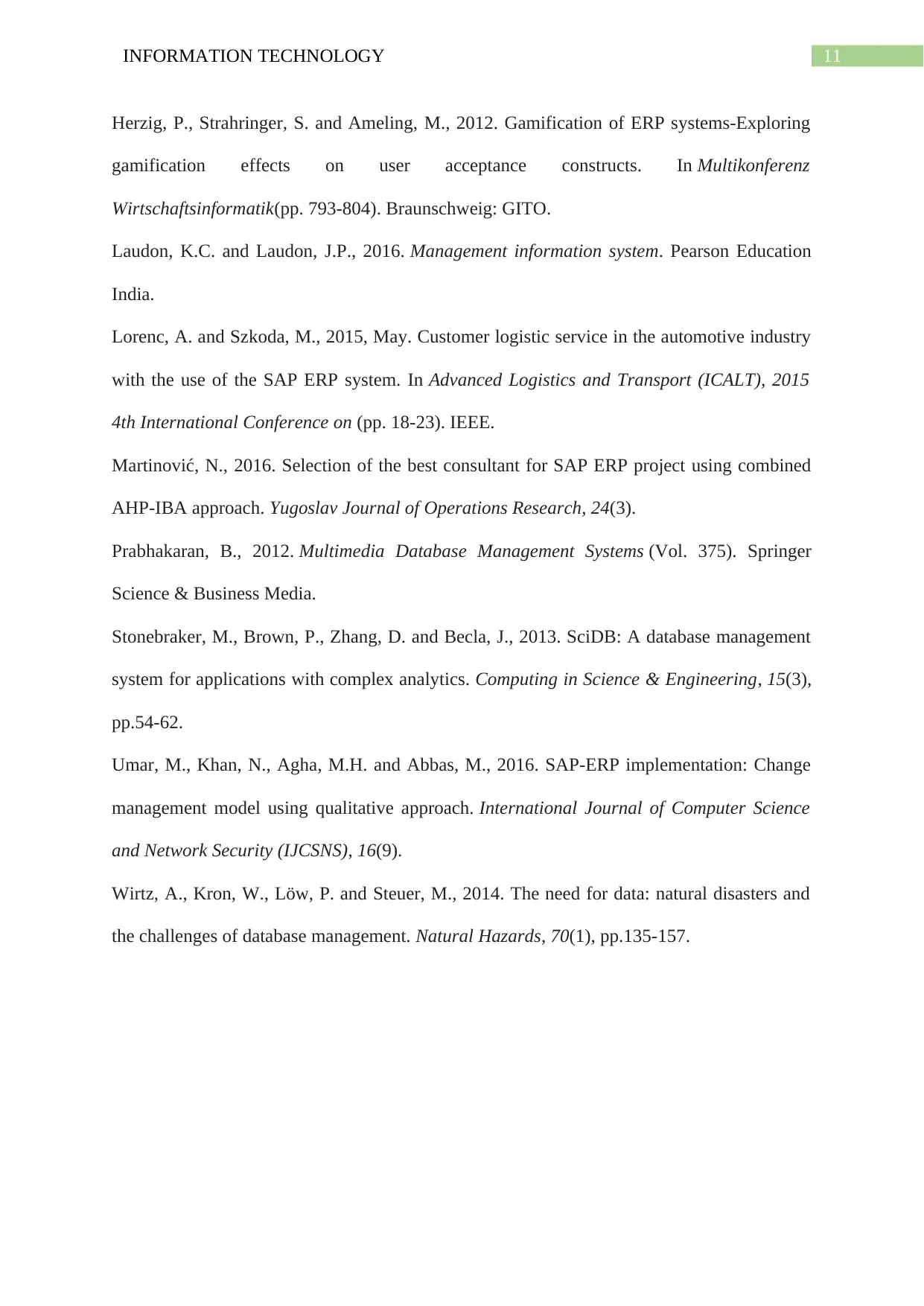
11INFORMATION TECHNOLOGY
Herzig, P., Strahringer, S. and Ameling, M., 2012. Gamification of ERP systems-Exploring
gamification effects on user acceptance constructs. In Multikonferenz
Wirtschaftsinformatik(pp. 793-804). Braunschweig: GITO.
Laudon, K.C. and Laudon, J.P., 2016. Management information system. Pearson Education
India.
Lorenc, A. and Szkoda, M., 2015, May. Customer logistic service in the automotive industry
with the use of the SAP ERP system. In Advanced Logistics and Transport (ICALT), 2015
4th International Conference on (pp. 18-23). IEEE.
Martinović, N., 2016. Selection of the best consultant for SAP ERP project using combined
AHP-IBA approach. Yugoslav Journal of Operations Research, 24(3).
Prabhakaran, B., 2012. Multimedia Database Management Systems (Vol. 375). Springer
Science & Business Media.
Stonebraker, M., Brown, P., Zhang, D. and Becla, J., 2013. SciDB: A database management
system for applications with complex analytics. Computing in Science & Engineering, 15(3),
pp.54-62.
Umar, M., Khan, N., Agha, M.H. and Abbas, M., 2016. SAP-ERP implementation: Change
management model using qualitative approach. International Journal of Computer Science
and Network Security (IJCSNS), 16(9).
Wirtz, A., Kron, W., Löw, P. and Steuer, M., 2014. The need for data: natural disasters and
the challenges of database management. Natural Hazards, 70(1), pp.135-157.
Herzig, P., Strahringer, S. and Ameling, M., 2012. Gamification of ERP systems-Exploring
gamification effects on user acceptance constructs. In Multikonferenz
Wirtschaftsinformatik(pp. 793-804). Braunschweig: GITO.
Laudon, K.C. and Laudon, J.P., 2016. Management information system. Pearson Education
India.
Lorenc, A. and Szkoda, M., 2015, May. Customer logistic service in the automotive industry
with the use of the SAP ERP system. In Advanced Logistics and Transport (ICALT), 2015
4th International Conference on (pp. 18-23). IEEE.
Martinović, N., 2016. Selection of the best consultant for SAP ERP project using combined
AHP-IBA approach. Yugoslav Journal of Operations Research, 24(3).
Prabhakaran, B., 2012. Multimedia Database Management Systems (Vol. 375). Springer
Science & Business Media.
Stonebraker, M., Brown, P., Zhang, D. and Becla, J., 2013. SciDB: A database management
system for applications with complex analytics. Computing in Science & Engineering, 15(3),
pp.54-62.
Umar, M., Khan, N., Agha, M.H. and Abbas, M., 2016. SAP-ERP implementation: Change
management model using qualitative approach. International Journal of Computer Science
and Network Security (IJCSNS), 16(9).
Wirtz, A., Kron, W., Löw, P. and Steuer, M., 2014. The need for data: natural disasters and
the challenges of database management. Natural Hazards, 70(1), pp.135-157.
⊘ This is a preview!⊘
Do you want full access?
Subscribe today to unlock all pages.

Trusted by 1+ million students worldwide
1 out of 12
Related Documents
Your All-in-One AI-Powered Toolkit for Academic Success.
+13062052269
info@desklib.com
Available 24*7 on WhatsApp / Email
![[object Object]](/_next/static/media/star-bottom.7253800d.svg)
Unlock your academic potential
Copyright © 2020–2025 A2Z Services. All Rights Reserved. Developed and managed by ZUCOL.





